You’re having difficulties getting it to start, and you’re wondering how to start a lawnmower that’s been sitting for a long time. You’ve arrived at the appropriate article, as we’ll give you the information you want to quickly get your mower properly up and running.
To start a sitting lawnmower:
- Examine & Change the Oil
- Remove the Oil
- Inspect the Gas Tank for Leaks
- No-Hassle Gas Recommendation
- Purchase and Change an Air Filter
- Change and Replace the Spark Plug
- Tighten the Brake Cable
- Examine the Condition of the Carburetor
- Replace Your Fuel Pump
- Examine the Flywheel.
Now you’re ready to mow the lawn with ease!
Starting a Lawnmower That Won’t Start After Sitting
Make use of the information on this page as a guide.
Here’s an introduction to lawnmowers, as well as instructions on how to start a lawnmower that has been resting for a while!
It should be beneficial regardless of the sort of lawn mower you have.
First and foremost, when operating with a lawnmower, it is critical to take appropriate safety precautions.
Remember to put on some protective gloves and safety glasses, as well as to be cautious of the sharp blade and engine parts.
Examine & Change the Oil
It’s always a good idea to inspect the oil in a mower that has been resting for a long period.
Change the oil in your mower approximately one hour after you have finished mowing.
However, if it has been sitting for the whole winter, you should check the oil before even attempting to start it.
First, make sure that the oil is of excellent quality, that there is no residue in it, and that there is enough.
Changing the oil when the oil is dark or black will ensure that your mower runs smoothly and lasts for a long time.
In the course of a year, I change the oil in my lawnmower twice – once at the start of the season and once more right before putting it away for the winter.
If you haven’t done so recently, just change the oil in your lawn mower’s engine. Even if this isn’t the major issue that’s stopping your mower from starting, it’s likely to be a contributing component in the situation.
Mowers are little engines that don’t require a lot of oil to function properly. As a result, it is a relatively affordable tune-up to perform yourself at home. With a walk-behind mower, you’re looking at 10 minutes or less per acre of grass.
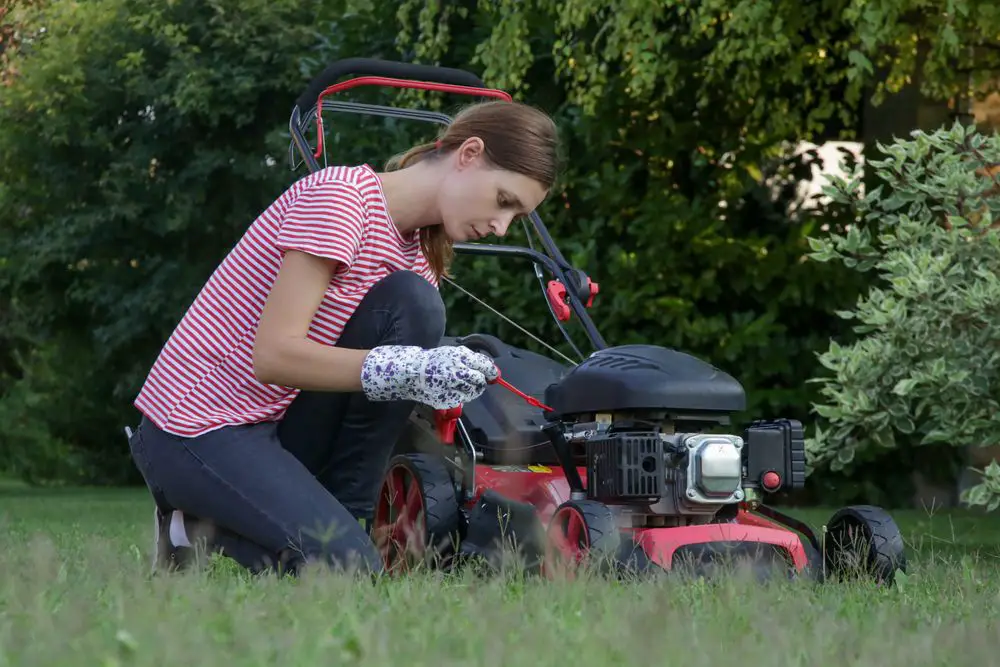
How to Get Rid of Your Lawn Mower Oil
Make certain that the oil is collected in a suitable container. You want something that has a tight-fitting cap and will not spill.
You can usually purchase such a container from your local car shop. Most of the time, your local mechanic or oil change business will accept your used motor oil. However, if this is not the case, there may be disposal options available at your local landfill.
If you notice smoke coming from the mower, this is yet another indication that the oil needs to be checked and replaced immediately.
A mower that won’t start will not produce smoke.
Nonetheless, it’s worth mentioning as something to keep an eye out for to keep your mower in good working order.
A smoking mower might be a sign that there is an oil leak somewhere in the machine. As a result of the leak, the oil ignites when it comes into touch with heated metal.
It might also suggest that there is insufficient oil in the system, which could result in irreparable damage to your engine.
Inspect the Gas Tank for Leaks
Have you ever contacted technical assistance for any electrical appliance and the first question you is whether or not your appliance is plugged in?
The same may be said for your lawnmower. Make certain that you have gas in your tank!
Gasoline is a volatile fuel that is not particularly stable. If the gas in your mower has been sitting in the tank for more than 30 days, you’ll need to empty it.
You may be able to dump the tank simply by tipping the mower. If this is the case, you will need to siphon it.
After you’re finished, refill the mower’s gas tank with new gas. To be really effective, you would need to have placed a gasoline stabilizer into the gas tank before storing. Then this fix would not be necessary.
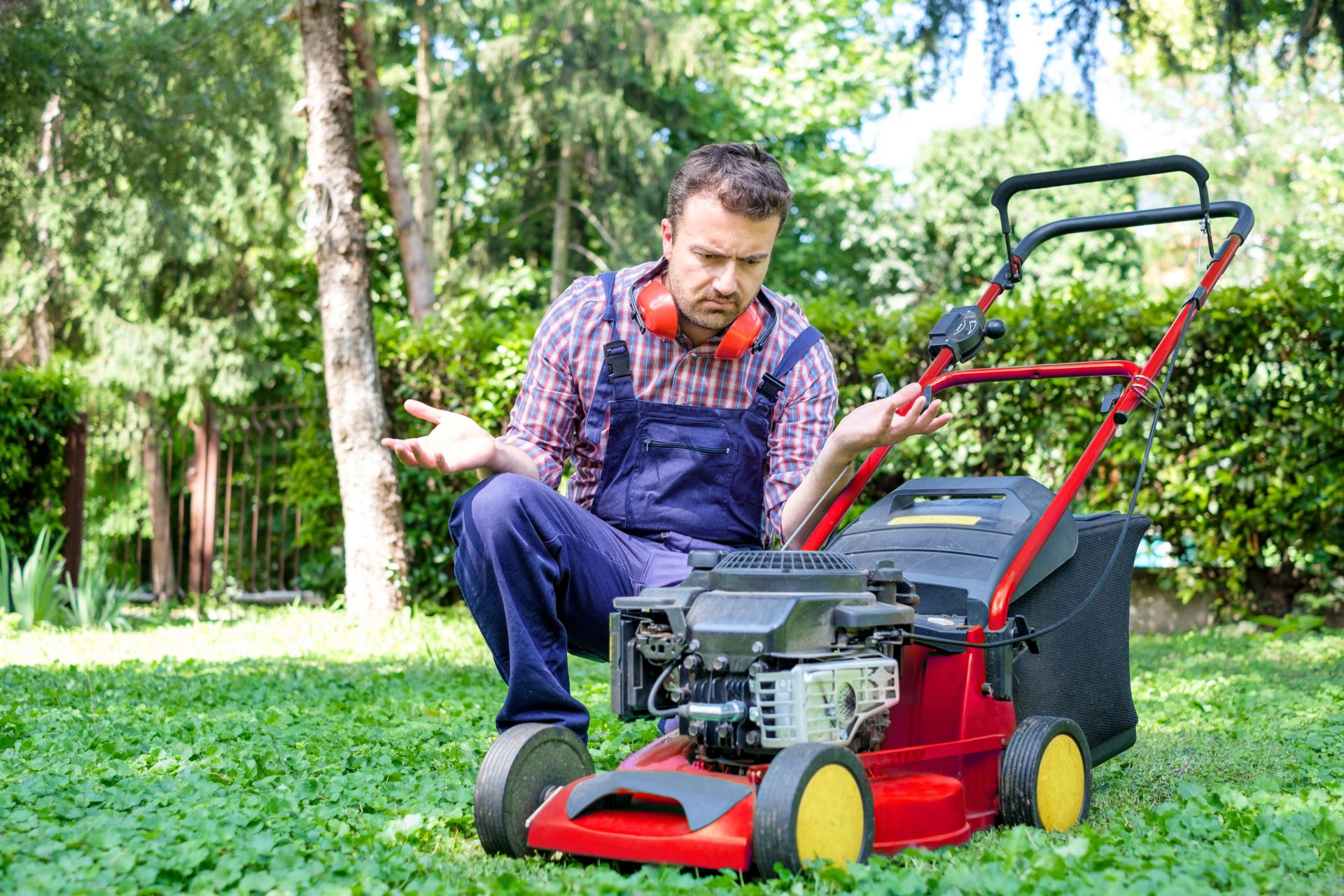
No-Hassle Gas Recommendation
No need to add a gasoline stabilizer, it runs clean, and it can be left in your mower all winter, and will start on the first pull when you want to start it.
Although it is more expensive than conventional gas, it is less expensive than replacing your mower or purchasing a new carburetor regularly.
If you find yourself having to siphon out the old gas and replenish it, keep in mind that lawnmowers use the same fuel as your automobile.
If you don’t want to try to dispose of it, you can typically just fill up your car’s petrol tank instead.
Just make sure it isn’t polluted gas, and if it is, be sure to dispose of it appropriately following your local municipal ordinances and regulations.
Change The Air Filter
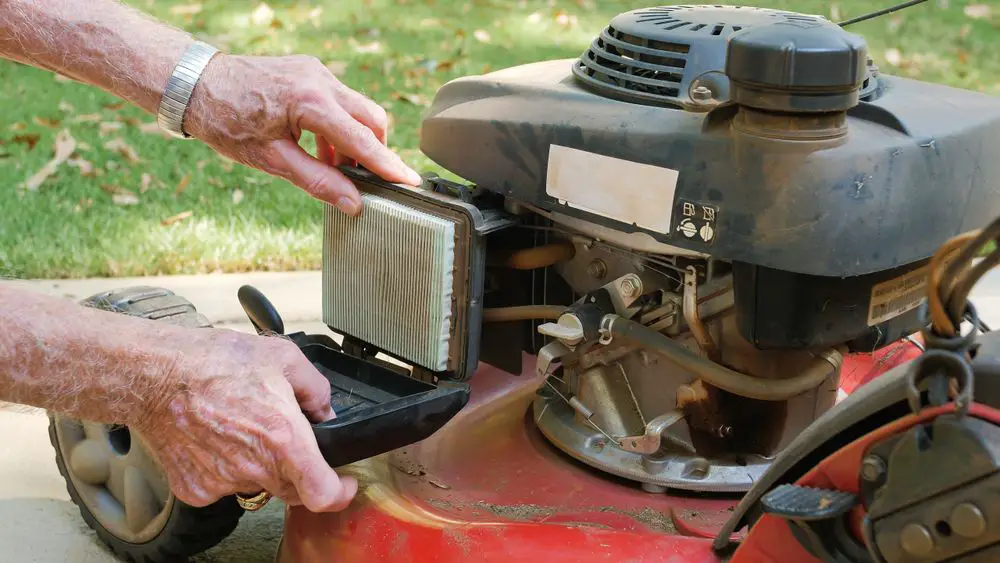
After you’ve checked the gas tank and changed the oil, you should inspect the air filter on your lawn mower. These have the potential to get clogged.
In an engine, oxygen is a critical component of the combustion process. If the air filter in your mower is clogged, your mower will not perform optimally (or at all).
An unclogged filter should be replaced rather than attempting to be cleaned.
Dual-element air filters and foam-only air filters are the two types of air filtering systems available. If you have a foam filter, it might help to keep debris and grime out of your engine when you apply motor oil.
If your filter isn’t lubricated, big particles will be caught and will not pass through. As a result, it should be replaced at least once every three months.
Even if it doesn’t appear that there is any damage, you must replace the tires.
Starting with the filter, unscrew the screw and pull it out of the way. Remove the foam and thoroughly clean the metal components.
Get a new foam filter and soak it with new engine oil before installing it. Take a clean cloth and gently wipe away any excess oil. Reassemble the filter and replace the carburetor once it has been cleaned.
Remove the knob from your dual element filter first if you have one.
Remove the foam pre-cleaner from the cartridge and replace it.
Before reinstalling the knob, make sure it is in good working order.
If there is excessive filth or damage, or if it is no longer fitting well, it should be replaced.
Even a little puncture in the filter might allow dust or residue to enter the engine, causing it to malfunction.
The fact that your lawn mower starts but then stops while you are mowing the grass is a very revealing symptom that the air filter is blocked.
You may also have a peek at it. If it is filthy, you will be able to know because, well, it will appear filthy.
Where Can I Purchase an Air Filter for My Lawn Mower?
Most big-box retailers in your area will most likely have in stock the air filter you need for your mower. The cost of a new one will be roughly $10 in most cases.
To maintain your vehicle properly, it is advised that you replace your air filter once a year.
If you can locate the air filter on your mower, you should be able to swap it out.
Don’t let the size of the task frighten you. It’s as simple as removing the old air filter and replacing it with the new one.
It’s possible that your blocked air filter isn’t the only problem.
If your lawn mower isn’t starting, it’s a good idea to replace the filter while you’re troubleshooting the problem.
Replace the Spark Plug of Your Lawnmower
The spark plug for your lawnmower may be found near the front end of the machine (especially with a walk-behind mower). It is easy to locate since it’s attached to a wire that makes it easy to identify.
This is typically made of black rubber and is designed to protect dirt and debris from getting into the spark plug. Examine the wiring to ensure that it is in excellent condition and that there is a secure connection.
The spark plug itself should be checked as the following item on the list.
A socket wrench may be used to remove the spark plug from your lawnmower. You may have to experiment to find the perfect size.
Alternatively, you may search it online. With a few easy twists, the old spark plug should be able to be removed.
When you remove the spark plug, it will be immediately apparent if you need to replace it.
Look for rust or discoloration at the business end of the spark plug’s spark plug connector. That’s the end that was in the mower before it broke (the one with the threads and the small metal piece sticking out).
It should not have any rust on it at any time. To test whether it will function, you may try cleaning it up and reconnecting it to see if it helps.
However, if you are in doubt, simply replace the spark plug.
How to Change the Spark Plug in a Lawn Mower?
This is a straightforward task, like changing the air filter.
All you must do now is obtain the suitable socket wrench for your plug and be careful not to over tighten it when you replace it with the replacement.
Even if your spark plug appears to be in good condition, it is preferable to get it replaced instead. It is recommended that you perform it once a year.
This is a good moment to remind you that if you decide to troubleshoot anything with the lawn mower’s engine, it is always preferable to disconnect the spark plug first.
This is a precautionary measure to guarantee that the engine does not start while you are working on the vehicle.
Simply unhook the black wire/cable that leads to and covers the end of the spark plug and remove it from the vehicle.
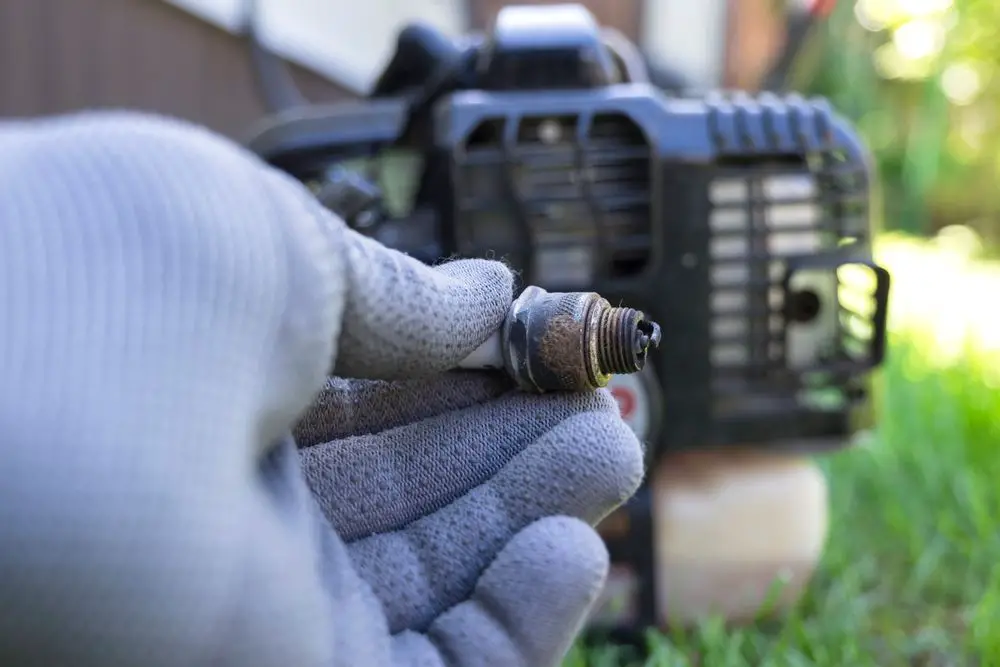
Tighten the Brake Cable of the Lawnmower
If the brake cord on your lawnmower is loose, it is possible that the mower may not start.
Pulling on the brake lever and then pulling on the brake cable with your hand can reveal if the brake is correctly tensioned or whether there is any give in the cable.
A simple way to discover whether this could be the source of your problem is to try starting the mower while holding the brake cord tightly in place.
If the mower starts, you’ll know that your brake cable must be tightened more.
Normally, this is a straightforward task. Using a crescent wrench and a pair of vice grips, you can accomplish the task in record time.
Examine the Condition of the Carburetor
Cleanliness is always essential for the carburetor of a lawnmower. This may be accomplished by frequent carburetor cleaning using a carburetor cleaner spray. It is easy to get by and is also reasonably priced.
First, remove the air filter from the vehicle and thoroughly clean it with the spray gun. Keep it like this for a few minutes to let the dirt loosen up a little more.
Some carburetors contain a float bowl, which must also be cleaned regularly. To get rid of the contents, you’ll need to remove the drain stopper and empty the bowl of any remaining gas.
Then you must remove the bowl and use the same spray to wipe the surface of the bowl. Sometimes, this is all that is required.
However, if it doesn’t work, you may need to disassemble the carburetor and do a thorough cleaning operation. Check the assembly thoroughly before reassembling it to avoid leaks and unwanted vapors entering the surface.
Is It Time to Replace Your Fuel Pump?
The fuel pump does exactly what it says on the tin: it pumps fuel from the gas tank into the engine through a set of three ports on the side of the vehicle.
If there is an excessive amount of oil in the engine, the oil can seep into the fuel pump (particularly, into the pulse port line), causing the fuel pump in your mower to become faulty and inoperable.
The pulse port line, valves, and diaphragm inside the fuel pump should all be checked to see whether the fuel pump is no longer functioning properly.
If you’ve tried all the other possible solutions in this article and your mower still won’t start, it’s time to replace the fuel pump on your mower.
Because of this, it is not feasible to fix the gasoline pump; instead, it is necessary to replace it. However, it is far less expensive than purchasing a new mower.
Examine the Flywheel
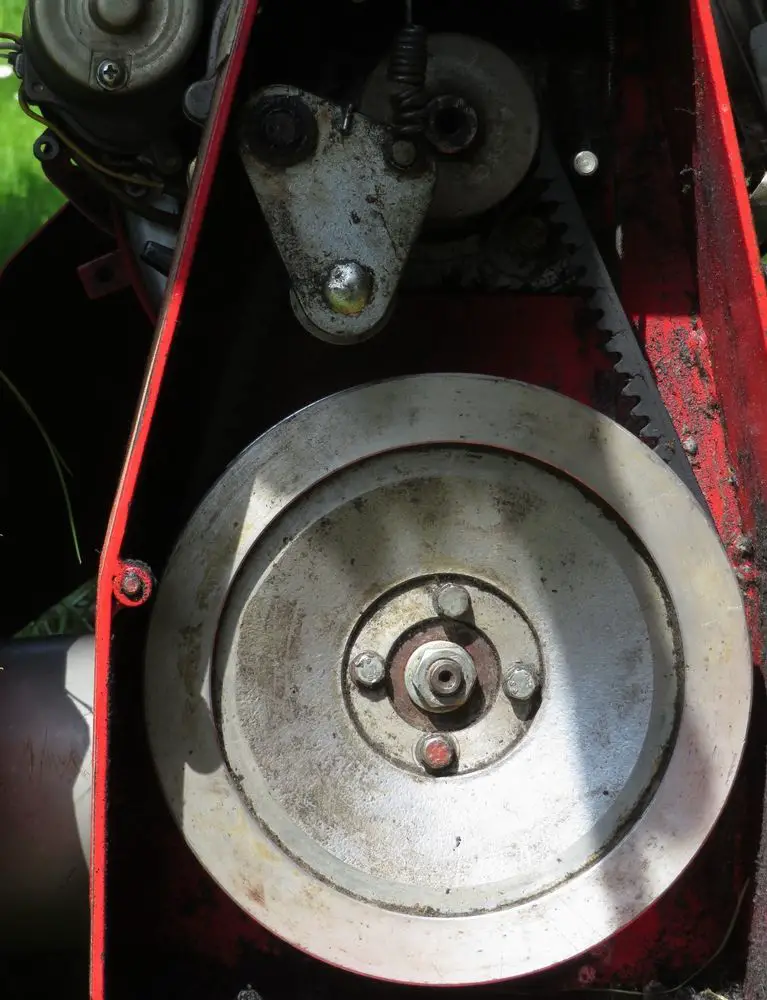
In the mower, the flywheel is the large horizontal spinning wheel that rotates counterclockwise.
When you start your walk-behind the mower, this is the portion that starts spinning as soon as you pull the starter cord.
When you hit a hard item with the mower, the flywheel key might be broken, which stops the mower from starting when you pull the cord to start it.
Likely, this isn’t an issue if you’re asking how to start a lawnmower that’s been sitting since the beginning of the winter season. If you strike a root, a rock, or a huge falling tree branch on your final mowing of the season, this might be the source of your problem.
The flywheel key on your mower will need to be removed to be checked for proper operation.
Flywheel removal is a time-consuming operation since the nut that holds it in place is extremely tight, and the flywheel must remain motionless to loosen the nut that holds it in place.
Final Thoughts on Starting a Lawnmower That Won’t Start After Sitting
Don’t give up on your lawn mower; likely, it’s still worth repairing.
After three years of trying, many people give up on a lawnmower that won’t start after the winter, sending it to the garbage and spending thousands of dollars on a fresh new model.
There are few exceptions, but for the most part, a lawnmower that won’t start after being parked is not broken; rather, it requires regular maintenance.
Most lawn mowers can be repaired and made to function again with a little troubleshooting.
Usually, if you’ve successfully resolved the issue with your mower, you’ll have gained a great deal of knowledge about how to manage it in the future. You won’t have any troubles in the future if you do this.
Even if this is your first time performing these repairs, they are simple and may be completed in your garage at a low cost. You may get the parts you require at your local hardware shop or on the internet.
Aside from keeping your mower out of the garbage, maintaining it may also save you money and provide a great deal of personal joy.
To be on the safe side, if all else fails and you are forced to purchase a new mower, check to see if your old one could be salvageable for spare parts before tossing it in the trash.
Most likely, there are several small engine repair companies in the area that would be pleased to give you a few dollars for it or would gladly accept it for free if you gave it to them!
Read More:
Best Lawnmowers —A Complete Guide
Starting a Lawnmower That Won’t Start After Sitting
Can Lawnmowers Get Wet? Three Tips On What To Do When A Mower Gets Wet.

